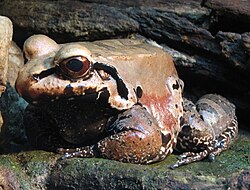| Leptodactylus | |
|---|---|
 | |
| Leptodactylus albilabris | |
| Scientific classification | |
| Kingdom: | Animalia |
| Phylum: | Chordata |
| Class: | Amphibia |
| Order: | Anura |
| Family: | Leptodactylidae |
| Subfamily: | Leptodactylinae |
| Genus: | Leptodactylus Fitzinger, 1826 |
| Species | |
Many—see text | |
Leptodactylus is a genus of leptodactylid frogs. [1] It includes the species commonly called ditch frogs or white-lipped frogs. [2] It is very similar to Physalaemus , a close relative, and indeed the 2005 described Leptodactylus lauramiriamae is in some aspects intermediate between them. [3]













